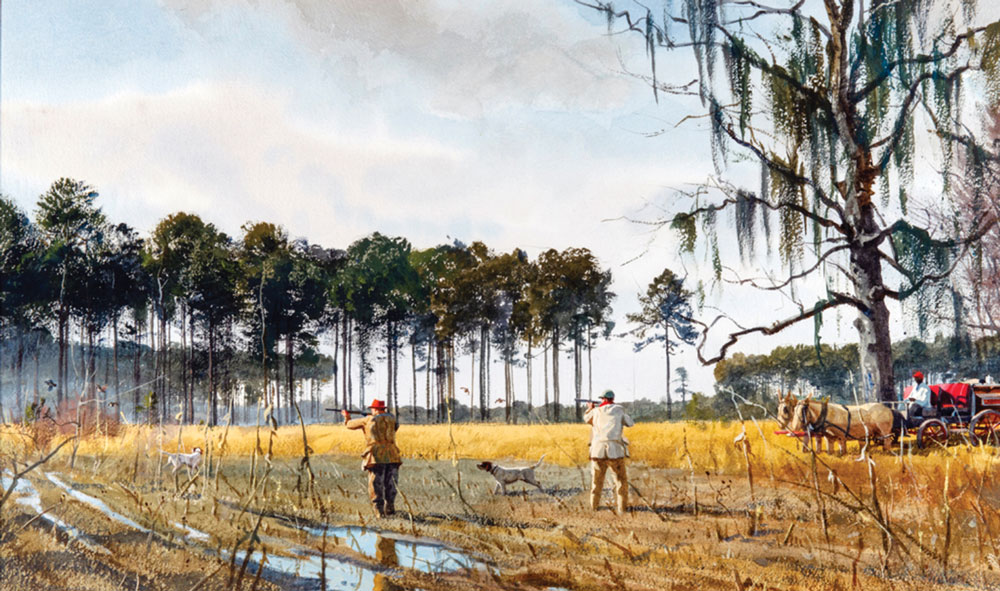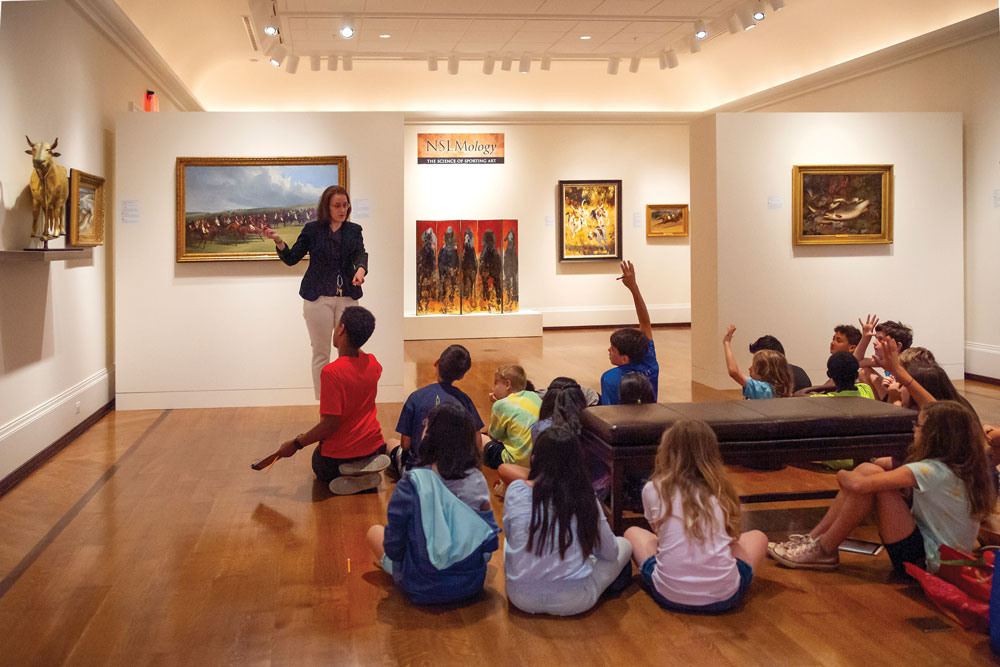National Sporting Library & Museum’s New Exhibit Pairs Science & Art

By Heidi Baumstark
Unique pairings. When blended well, they yield beautiful results. The National Sporting Library & Museum (NSLM) in the historic village of Middleburg has struck the perfect combo of science and art through its new exhibition NSLMology: The Science of Sporting Art, which debuted April 12 and runs through Sept.15.
NSLM is a six-acre property that includes a library and research facility in one building; and in another building—the historic 1804 brick house called Vine Hill—an art museum where the NSLMology exhibit is located on the second floor. NSLM is dedicated to preserving, promoting and sharing the literature, art and culture of equestrian, angling, and field sports, stewarding more than 20,000 rare books (literature dating from 1523 to the present). In addition to books and archival collections, NSLM has over 1,300 works of art within its permanent collection spanning from circa 1690 to the present, including paintings, sculptures, works on paper, photographs, dog collars, trophies, and decorative objects.
NSLMology allows people to learn how science is at work in various art forms incorporating scientific principles: motion, weather, ecology, color theory, and chemistry. Visitors of all ages will experience scientific principles within three centuries of paintings, sculptures, and works on paper. Hands-on activities and a Family Activity Guide serve as tools to use while viewing the exhibit’s five areas of scientific exploration. NSLM’s Executive Director Elizabeth von Hassell said, “NSLMology uses the museum’s permanent collection—which is comprised of art generously donated or bequeathed to the institution—to explore these five scientific principles, looking at sporting art in a different perspective and places it into context.”

For example, prominent American sporting artist, Ogden Minton Pleissner’s (1905-1983) The Covey Rise, is a watercolor that shows two men, guns raised, and taking aim at a covey of quail, grasses surrounding them with a small pool of water nearby. Clouds fill the sky, but not overly overcast. The men are hunting bobwhite quail, birds known for living in a habitat like the one depicted. These quail were once prevalent throughout the eastern United States but have been in sharp decline since 1966 due to habitat loss. The clouds appear to be stratus clouds, which is generally indicative of a light rain or fog. “Viewing this artwork from a scientific view, the loblolly pine trees shown in the back and the lone oak tree on the right are unique to the southeastern United States, placing the scene in a very distinctive wetlands setting,” von Hassell pointed out. Combining these scientific principles in nature with pieces of art offers a holistic, well-rounded experience.
“This is just one example of how we are using the works in our permanent collection to add scientific context. In addition to paintings, there are bronze sculptures (one you can touch), a weathervane, a decorative art screen, photographs, and prints,” von Hassell said.
Jody West, marketing manager for NSLM, said, “NSLMology is the first of its kind as a hands-on activity exhibit for NSLM. People learn best when integrating topics and with an interactive approach.” The motion and color theory sections have hands-on activities, and another room focuses on the science of chemistry in works of art where bronze sculptures are displayed. To teach how bronze pieces are made, a video plays to show lost-wax casting, a process by which a duplicate metal sculpture is cast from an original sculpture. Claudia Pfeiffer, the George L. Ohrstrom, Jr. curator at NSLM, said, “We want to be a stopping point—a destination—for educators, parents, and students.”

One of those educators is Ashley Sullivan who is in her third year of teaching at Middleburg Community Charter School. A graduate of the Corcoran School of the Arts and Design in D.C., Sullivan brought her fourth- and fifth-grade students to the exhibit in May. She believes in the importance of an integrated approach to learning instead of what she called teaching “siloed” subjects. Last fall, Sullivan began building a professional relationship between NSLM and her school. “I learned about this new exhibit coming in 2019 and discovered it fell in line with the Virginia SOLs [Standards of Learning],” she said.
While visiting the exhibit, Sullivan’s students enjoyed a hands-on activity learning about the zoetrope, an old Victorian-era (1837-1901) pre-film animation device that produces the illusion of motion by displaying a sequence of drawings or photographs in progressive phases of motion. It was a form of entertainment in that era. During the group tour, Pfeiffer led a discussion about animals in art pieces and asked questions to help students think, such as, “Why is there hay in the chicken coop?” And comparing/contrasting questions such as: “How can you tell if animals are healthy?”
“The exhibit lends itself to lots of classroom ideas that become relatable for those who aren’t necessarily ‘sporting people’. “The idea of looking at weather, ecosystems, habitats, etc. in combination with field sports and how all of these work together deepens our understanding of art. Once you starting thinking in that direction, it opens up a broader educational approach that link principles together,” said Pfeiffer.
Sullivan spoke of the importance of building relationships with this local, world-class museum. “It’s within walking distance from the school,” she said. “To have a museum take such thought and care that meets SOL standards [in this exhibit] is really great. We want to take advantage of it and definitely plan to take students to future exhibits and utilize the research library, too. We work hard at our school to cultivate interest in art—in all its forms—including music, drama, dance, poetry, and visual arts.”
“This exhibition allows us to connect with the community, kids and families, in a broader way during the summer months. Big picture, our main goal is to be a hub for visitors of all ages to engage with our sporting art and literature in traditional, contemporary, and scholastic ways,” said Von Hassell. Sullivan ended, “Hopefully our relationship with NSLM grows.” Now that’s a pairing that makes sense.
Originally known as the National Sporting Library, the non-profit was founded in 1954 by George L. Ohrstrom, Sr., president of the Orange County Hunt and Alexander Mackay-Smith, editor of The Chronicle of the Horse. The library, built in 1999, was designed as a facility for book stewardship and research; it includes the Forrest E. Mars, Sr. Exhibit Center and the Founders’ Room for public events. The culture and history of country sport—horsemanship, polo, coaching, steeplechasing, foxhunting, flat racing, angling, shooting, and wildlife—are the subjects to explore inside its generous stacks of rare books, archives, and art collection.
Other events for the whole family include Open Late, a free community summer evening concert series held on the museum lawn the last Friday of the month, May through August. Concerts are free and open to the public; the next one is Aug. 30. Gallery Talks are scheduled every Wednesday at 2 p.m. when staff offer attendees a peek at traveling exhibits, new acquisitions, or pieces in their permanent collection. Admission is free and reservations are not required.
Sunday Sketch is another free program for all ages held the first Sunday of the month from 2-4 p.m. Each month, a local art teacher or artist leads sketching sessions in the art galleries. Supplies (pencils, paper, sketch boards, and clipboard) are provided and pre-registration is encouraged.
NSLM is located at 102 The Plains Road in Middleburg. Call 540-687-6542 or visit www.nationalsporting.org. This article first appeared in the August 2019 issue of Middleburg Life.


